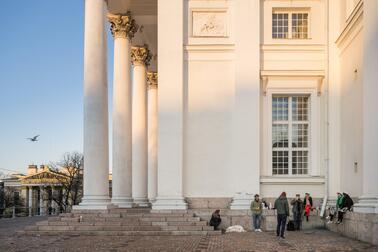
The starting point of the Helsinki cultural environment programme is the preservation, development and utilisation of diverse tangible and intangible cultural heritage as a resource in Helsinki. To strengthen this work, the programme identifies a total of 38 actions whose implementation will be monitored until 2028. The programme brings together information that explains the development history of our environment and the identity of the region.
“Cultural environments are a key building block for the identity of the city and also its residents – it is the layered cultural environment built up in decades that makes Helsinki what it is. Therefore, the published programme is a significant addition and tool for developing cultural environments and the related cooperation. The vision of the cultural environment programme is that Helsinki, which will celebrate its 500th anniversary in 2050, will be a historically interesting city that values its cultural environments and changes sustainably. Cultural environments increase the attractiveness of the city and are the basis for the development of tourism,” says Sari Saresto, Project Manager of the cultural environment programme.
In addition to the programme’s policies, measures and impacts, the programme report summarises the history and architectural identity of Helsinki’s construction, the development and values of the Helsinki landscape and green spaces, and the characteristics of maritime Helsinki. The programme discusses the current state of the protection of cultural environments as well as identifies the areas for which protection goals have been defined. Among others, the point of departure in the ongoing large-scale urban rezoning is to update building protection.
Effectiveness through policy guidelines for the programme
A total of 38 measures have been included in the programme in the joint preparation of which the following have been highlighted as the most effective for the preservation of cultural environments:
- The values of nationally and locally significant built cultural environments and park and landscape culture will be preserved, and the quality of the care of cultural environments will be ensured. The goal of building protection is a layered, historically authentic Helsinki that has preserved is characteristics.
- Helsinki’s building heritage will be renovated sustainably. Sufficient resources must be secured for the use and good maintenance of valuable buildings.
- Cooperation channels will be strengthened and smooth and timely cooperation by the city ensured to preserve valuable cultural environments and building heritage, taking into account the other objectives of the city strategy.
- Helsinki will strengthen its knowledge base about cultural environments. Inventories and surveys will be commissioned in a timely manner and to an appropriate extent to support the planning of areas and in projects to repair valuable buildings. The most urgent of the inventories are the updating of Helsinki’s archaeological inventory and performing a school and day-care centre inventory.
- The usability, digital accessibility and openness of cultural environment data will be improved in electronic map services.
- Communication and awareness of cultural environments, their management, use and care will be increased.
- The impacts of the cultural environment programme will be evaluated in 2026 and 2028 together by the Helsinki City Museum and the Urban Environment Division. At the same time, the need to update the cultural environment programme will be evaluated.
Extensive preparatory process
The programme has been drawn up together by the Culture and Leisure Division and the Urban Environment Division in broad consultation with various stakeholders. The programme work was managed by the Helsinki City Museum, which was also responsible for promoting it. The aim of the work has also been to improve the flow of information and cooperation within the city. Since various decisions and measures concerning the cultural environment are made in the city’s various services and private projects, the practices already in place and the need to strengthen them have also been included in the programme.


